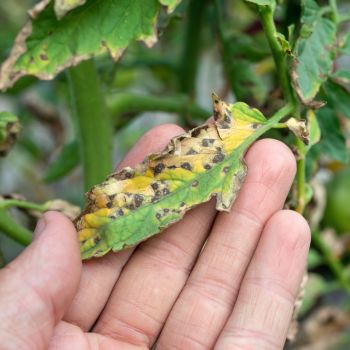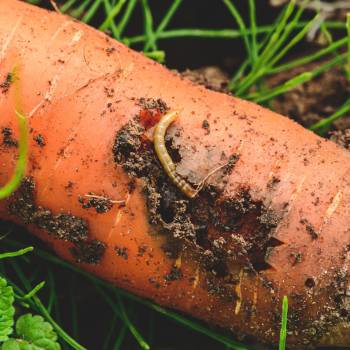Some garden pests are instantly recognisable. You'll never confuse a greenfly with an earwig, and a caterpillar chewing on a cabbage leaf will never be misidentified.
Scale, on the other hand, come in a wide variety of disguises, but the problems they cause can be just as severe.
Scale is actually a general term for a large group of tiny, sap-sucking pests which are common in agriculture and gardens across the country. There are hundreds of distinct scale species in Australia alone, with thousands identified globally.
Their appearance ranges from tiny shell-like spots only a millimetre or so across, up to oval or round growths measuring 5mm or more. Some scale species look like frost, some like rust, and they can come in colours ranging from brown through orange to white.
They often appear in clusters, fixed unmoving around the stems or branches of infested plants, although they can also set up home on leaf joints, leaves, or any other part of the host. They're particularly keen on fruit trees, especially citrus, but will also attack ferns, roses, palms, magnolia, and many more.
The whole group of scale species can be split into two main types, armoured and soft. As the names suggest, armoured scale develop a tough outer shell, while soft ones are much less rugged. However, both grow a protective mound or cover over their bodies as they mature, and it's this which gives them their appearance as speckles, bumps, or nodules on the plant's surface.
The Scale Life Cycle
Most scale begin life as eggs which hatch into crawlers, while other species produce live young. In both cases the mobile nymphs either move to a suitable feeding spot on the infested plant, or are blown on the breeze to another host.
They then settle down to a stationary life of feeding on the plant's sap until maturity, building their protective cover as they go. Females stay in the same spot for the rest of their lives, and die after producing up to 2,000 eggs.
In contrast, the males of many species eventually develop wings, and migrate to another plant to fertilise a new generation. But just to add another twist of complexity, many species of scale can reproduce asexually, and in some cases the male of the species has never been observed.
There will typically be two full generations per growing season, with the last batch of eggs lying dormant over winter.
The Problems Scale Cause
For such tiny and immobile creatures, scale can do a surprising amount of damage to your plants.
- The simple act of sap-sucking places the plant under strain, stunting growth and increasing its susceptibility to disease.
- As they feed, the scale secrete a honeydew which coats the leaves, blocking sunlight and reducing photosynthesis.
- The honeydew often causes sooty mould to develop, which can lead to leaf drop and dieback.
- The honeydew also attracts ants, which 'farm' the scale, protecting them from predators and even moving them from plant to plant to spread the infestation. Worse, the ants also do this for any passing aphids, so an increase in the ant population is doubly unwelcome.
- As the scale puncture the plant stems to feed, they can inject viruses and other pathogens, spreading disease around your garden.
For all of these reasons, a scale insect infestation needs to be dealt with quickly once it's spotted.
How to Handle Scale Problems
Although many types of insecticides are effective against scale, they carry the risk of harming beneficial insects as an unwelcome side effect. Because of this, physical methods are the better choice whenever possible for control and prevention.
However, if you do choose the insecticidal route, select a product aimed at scale rather that a broad use insectivide. This will help keep collateral damage to a minimum. For example, Eco-oil is an organic insecticide aimed at sap sucking insects that works by suffocation.
Here are some ideas for more closely targeted, eco-friendly solutions for scale infestations.
- Prune away the most heavily affected parts of each plant, if it's possible to do this without causing too much damage. If the plant is badly infested all over, it may be worth accepting the loss of it to prevent the problem from spreading around your garden. In both cases, dispose of infested material carefully, for example by burning rather than composting.
- Smaller amounts of scale can be physically brushed or wiped off the plant, using a light paintbrush or a damp cloth. However, take care not to damage the plant if the scale don't fall away easily.
- Use a water jet to knock the insects from their perches. As adults are generally immobile, once they're sent to the ground they won't be able to re-infest the plant.
- For another liquid-based solution, make a homemade spray using a mixture of soap, oil, and water. Spray the whole plant liberally, including underneath the leaves, and the mixture will suffocate the insects. However, take care not to spray your plants in direct sunlight or temperatures above 30C, as the leaves can easily scorch. Also check that the plant isn't also home to helpful insects such as ladybirds.
- Dab scale clusters with rubbing alcohol to dry them out. But don't overdo this: using too much alcohol will have a damagingly drying effect on your plants as well.
- If ants seem to be worsening your scale problem, make life difficult for them by ringing the base of affected plants with petroleum jelly to prevent access. Also, grow strong-smelling herbs such as lavender, fennel, peppermint, and chamomile close to areas which tend to be infested, as the odour is thought to drive ants away.
- Lastly, try encouraging beneficial insects and other predators into your garden. Growing a wide range of flowers will attract ladybirds and parasitic wasps naturally.
Nearly any garden will contain at least some scale, and in normal numbers they don't cause a huge problem. However, if the population becomes large enough to be noticeable, taking a few of these preventative measures will restore a safer balance without harming your garden's wider ecosystem.
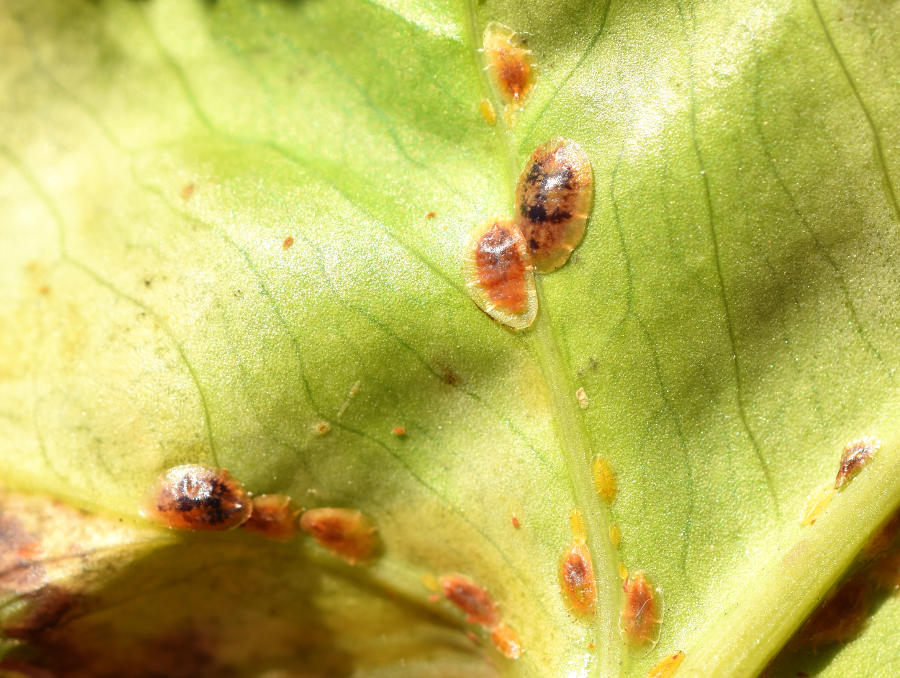
Scale insects on leaf
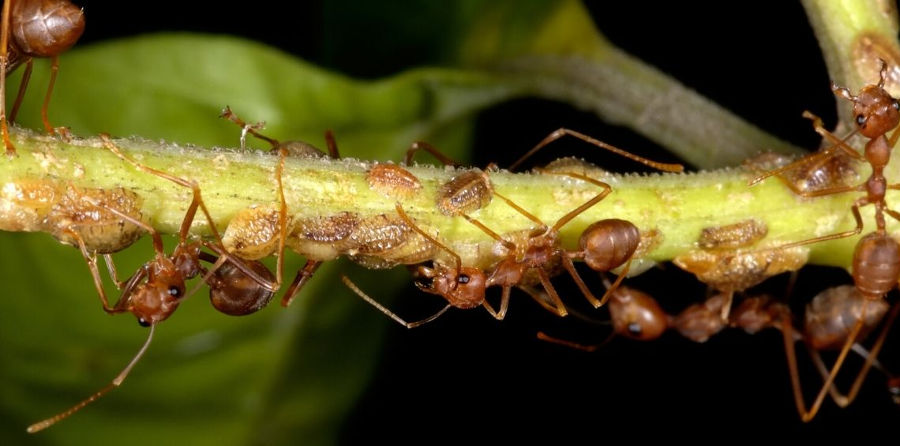
Ants farming scale insects
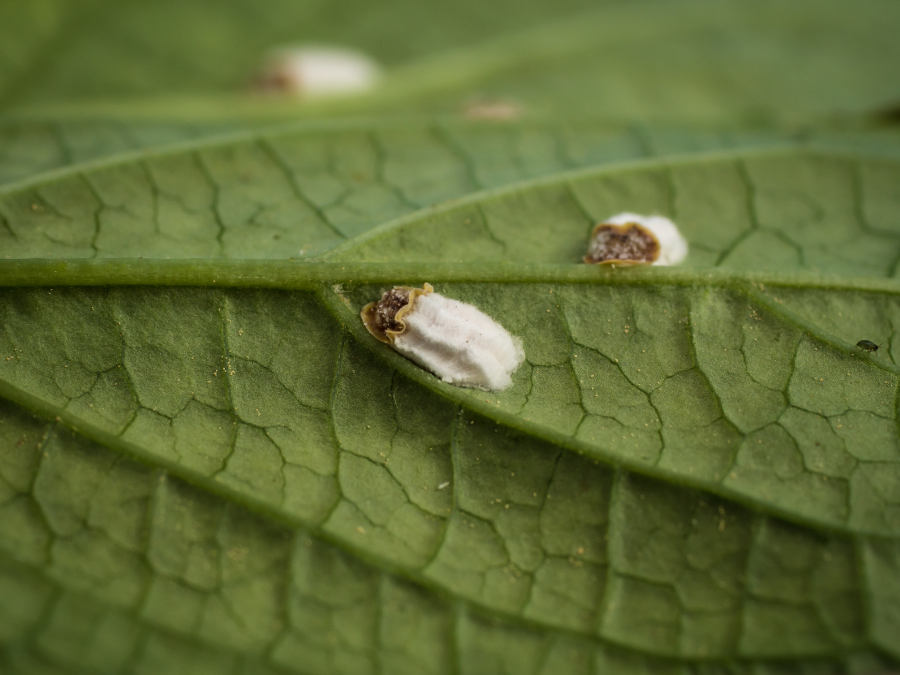
Scale insects with honeydew secretions.




